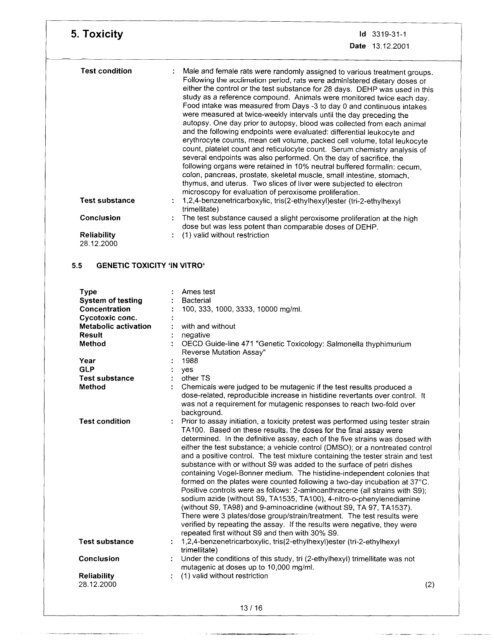Trimellitate Category; Revised Summaries - US Environmental ...
Trimellitate Category; Revised Summaries - US Environmental ...
Trimellitate Category; Revised Summaries - US Environmental ...
Create successful ePaper yourself
Turn your PDF publications into a flip-book with our unique Google optimized e-Paper software.
5. Toxicity Id 3319-31-1<br />
Test condition<br />
Test substance<br />
Conclusion<br />
Reliability<br />
28.12.2000<br />
5.5 GENETIC TOXICITY ‘IN VITRO‘<br />
Type<br />
System of testing :<br />
Concentration<br />
Cycotoxic cont.<br />
Metabolic activation :<br />
Result<br />
Method<br />
Year<br />
GLP<br />
Test substance<br />
Method<br />
Test condition<br />
Test substance<br />
Conclusion<br />
Reliability<br />
28.12.2000<br />
Date 13.12.2001<br />
: Male and female rats were randomly assigned to various treatment groups.<br />
Following the acclimation period, rats were administered dietary doses of<br />
either the control or the test substance for 28 days. DEHP was used in this<br />
study as a reference compound. Animals were monitored twice each day.<br />
Food intake was measured from Days -3 to day 0 and continuous intakes<br />
were measured at twice-weekly intervals until the day preceding the<br />
autopsy. One day prior to autopsy, blood was collected from each animal<br />
and the following endpoints were evaluated: differential leukocyte and<br />
erythrocyte counts, mean cell volume, packed cell volume, total leukocyte<br />
count, platelet count and reticulocyte count. Serum chemistry analysis of<br />
several endpoints was also performed. On the day of sacrifice, the<br />
following organs were retained in 10% neutral buffered formalin: cecum,<br />
colon, pancreas, prostate, skeletal muscle, small intestine, stomach,<br />
thymus, and uterus. Two slices of liver were subjected to electron<br />
microscopy for evaluation of peroxisome proliferation.<br />
: 1,2,4-benzenetricarboxylic, tris(2-ethylhexyl)ester (tri-2-ethylhexyl<br />
trimellitate)<br />
: The test substance caused a slight peroxisome proliferation at the high<br />
dose but was less potent than comparable doses of DEHP.<br />
: (1) valid without restriction<br />
Ames test<br />
Bacterial<br />
100,333, 1000,3333, 10000 mglml.<br />
with and without<br />
negative<br />
OECD Guide-line 471 “Genetic Toxicology: Salmonella thyphimurium<br />
Reverse Mutation Assay”<br />
1988<br />
9s<br />
other TS<br />
Chemicals were judged to be mutagenic if the test results produced a<br />
dose-related, reproducible increase in histidine revertants over control. It<br />
was not a requirement for mutagenic responses to reach two-fold over<br />
background.<br />
Prior to assay initiation, a toxicity pretest was performed using tester strain<br />
TAIOO. Based on these results, the doses for the final assay were<br />
determined. In the definitive assay, each of the five strains was dosed with<br />
either the test substance; a vehicle control (DMSO); or a nontreated control<br />
and a positive control. The test mixture containing the tester strain and test<br />
substance with or without S9 was added to the surface of petri dishes<br />
containing Vogel-Bonner medium. The histidine-independent colonies that<br />
formed on the plates were counted following a two-day incubation at 37°C.<br />
Positive controls were as follows: 2-aminoanthracene (all strains with S9);<br />
sodium azide (without S9, TAI 535, TAI 00) 4-nitro-o-phenylenediamine<br />
(without S9, TA98) and 9-aminoacridine (without S9, TA 97, TAI 537).<br />
There were 3 plates/dose group/strain/treatment. The test results were<br />
verified by repeating the assay. If the results were negative, they were<br />
repeated first without S9 and then with 30% S9.<br />
1,2,4-benzenetricarboxylic, tris(2-ethylhexyl)ester (tri-2-ethylhexyl<br />
trimellitate)<br />
Under the conditions of this study, tri (2-ethylhexyl) trimellitate was not<br />
mutagenic at doses up to 10,000 mglml.<br />
(1) valid without restriction<br />
(2)<br />
13116

















